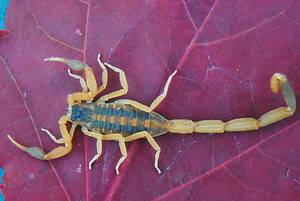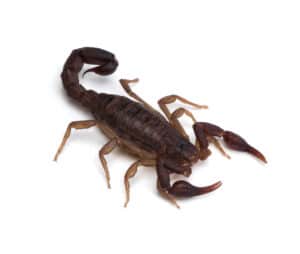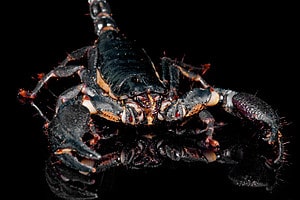Arizona is famous for having scorpions in its deserts that sometimes scurry into homes when the scorching summer weather hits. They also venture into homes during the cool winter months, which means that folks who live in dry, arid climates hardly catch a break from these venomous pests.
Scorpions are stinging arthropods with exoskeletons similar to shrimp shells. They’re arachnids that are related to ticks, spiders, and mites.
Some iterations of terrestrial scorpions have inhabited earth for 350 million years. This makes them one of the oldest animals on the planet.
While scorpions do sting, most are harmless because the amount of venom they release isn’t very dangerous to humans. Deaths from scorpion stings are extremely uncommon. Scorpions use their neurotoxic venom to immobilize prey that they crush with their pincers.
Scorpions can be found in almost every state of the United States, but as far as numbers go, there are more scorpions in Arizona, New Mexico, Texas, and California than in other states. What are the 4 scorpions in Arizona you will encounter? Here’s a preview:
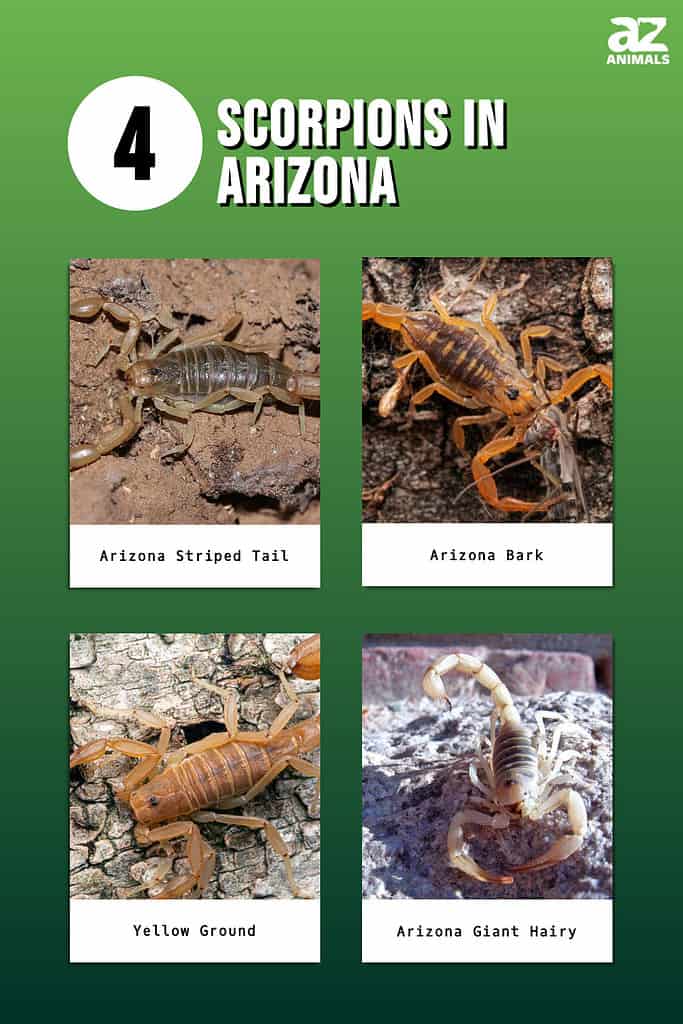
4 Scorpions in Arizona
Let’s look closer at these pictures and go over pertinent details now.
1. Arizona Striped Tail Scorpions
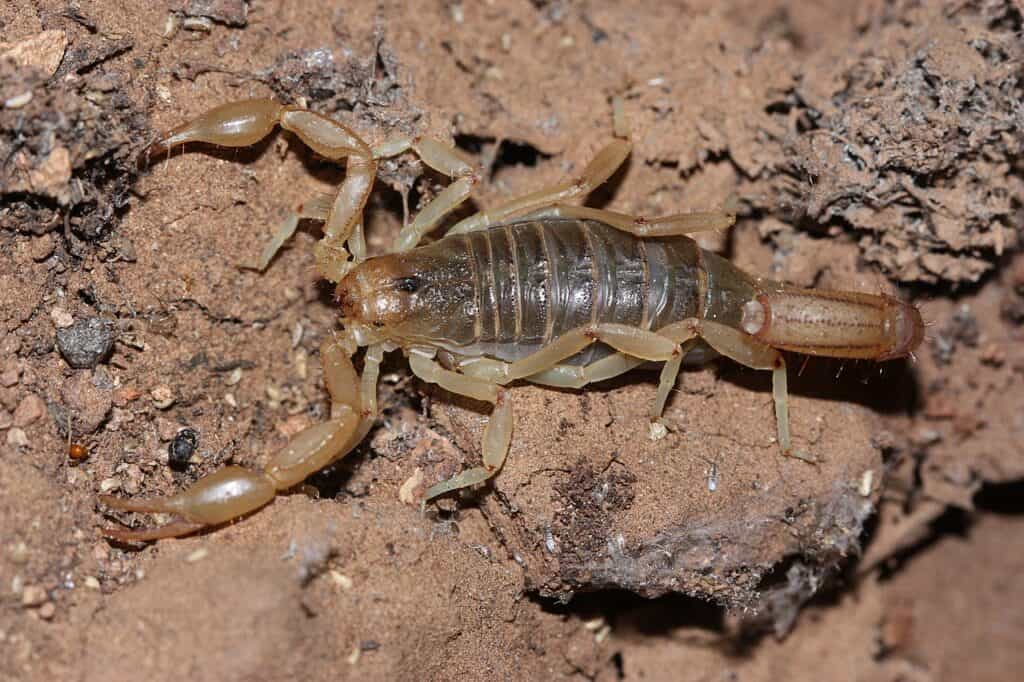
Encountering an Arizona striped tail scorpion in the open desert is common.
©Andrew Meeds / CC BY 4.0 – License
These scorpions love to hang out beneath rocks, and they’re the most common scorpions in the state. They’re one of the scorpions on our list that is commonly found in Arizonan homes. They chill under rocks during the heat of the day and search for prey at night.
They’re usually about 2 inches long. Arizona striped tail scorpions are found from sea level into higher mountain elevations. They’re medium in size compared to the other 4 scorpions found in Arizona.
They’re the most common animals found on the ground in the desert. Their tails have brown stripes on them, which makes them easily distinguishable from the other 4 main scorpions in Arizona.
2. Arizona Bark Scorpions
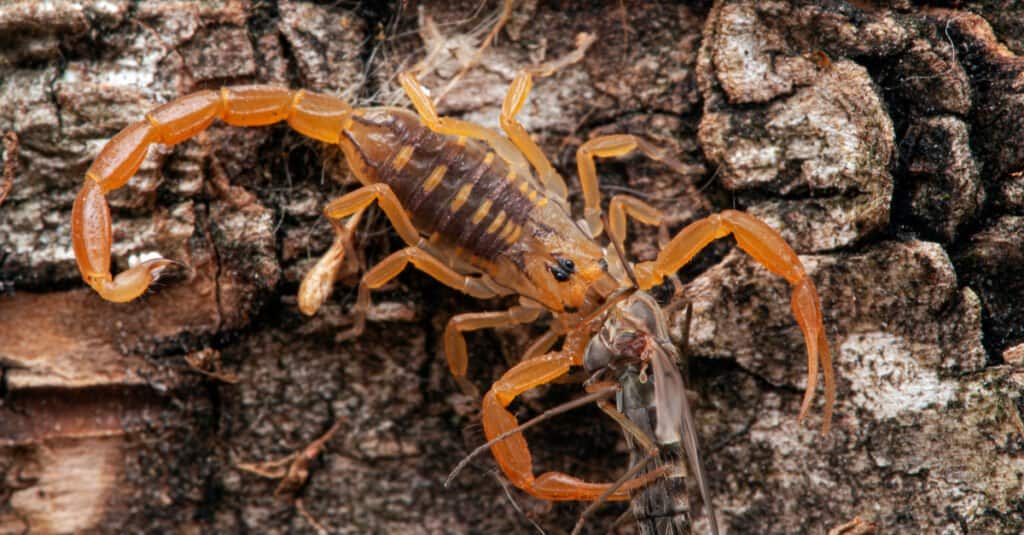
The venom of the Arizona bark scorpion is a major cause for concern.
©Ernie Cooper/Shutterstock.com
They are one of the most common scorpions encountered in Arizona. They like to hide in tree bark which is how they got their name. They also like rocky areas, and they’re one of the Arizonan scorpions on our list that’s a home invader.
They have a long metasoma which is their tail and stinger. They’re generally a sandy color though individuals at higher elevations are sometimes striped.
They’re long and slender with small pedipalps. Pedipalps are the official terms for a scorpion’s claws. Bark scorpions are petite in comparison to the other scorpions on our list.
The venom from these scorpions is a cause for concern, and they’re the only medically important scorpions in Arizona. Swelling and pain usually occur at the sting site, and sometimes symptoms can escalate. Breathing problems and muscle spasms are rare occurrences but do happen.
There is an antivenom available, and symptoms resolve within an hour and a half of its administration. Seek immediate medical care if a bark scorpion stings you.
3. Yellow Ground Scorpions
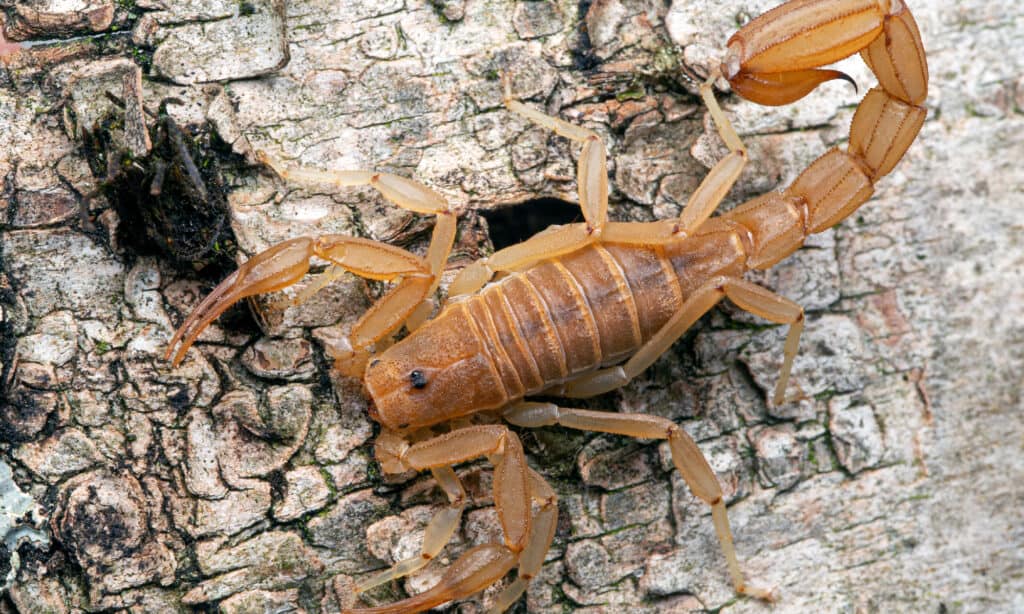
The yellow ground scorpion looks like a bark scorpion, but its sting isn’t worrisome.
©Ernie Cooper/Shutterstock.com
Yellow ground scorpions are often mistaken for the Arizona bark scorpion though they have a broader tail base. It’s a yellow scorpion, as its name suggests, with slender appendages.
These scorpions strike fear into the hearts of many because they have a venomous doppelganger. The venom of yellow ground scorpions isn’t worrisome and causes a minimal reaction.
4. Arizona Giant Hairy Scorpions
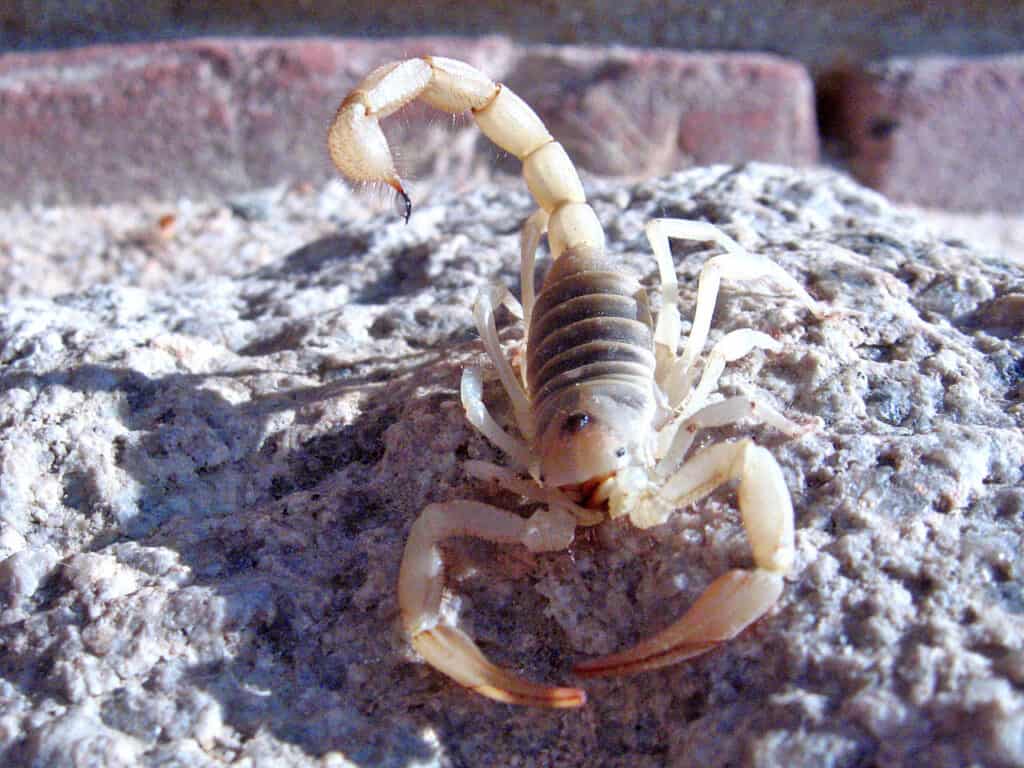
Arizona giant hairy scorpions burrow up to 8 feet into the ground in the summer.
©Robb Hannawacker, while working for Joshua Tree National Park / CC BY 2.0 – License
Arizona giant hairy scorpions are the biggest and hairiest scorpions in Arizona, as well as in the United States. They grow up to 6 inches in length. Their metasomas and pedipalps are hairy.
These scorpions eat other scorpions, small mammals, centipedes, and spiders that they find in saguaro forests. Saguaros are uniquely armed cylindrical cacti that are symbolic of Arizona and the desert.
Arizona giant hairy scorpions are burrowers that dig holes down to the water line under the desert floor. In the summer, when this water line goes deeper, Arizona giant hairy scorpions follow it. They build tunnels that are up to 8 feet deep.
The water line is the same as the top of the water table. It’s where, below the ground, water starts to fill the cracks and crevices between dirt and rocks. The ground is moist there the entire year but where this moisture begins depends on surface temperatures.
While this scorpion is intimidating, its sting only causes mild irritation and isn’t much of a cause for concern.
Why Do Scorpions Glow Under Blacklights?
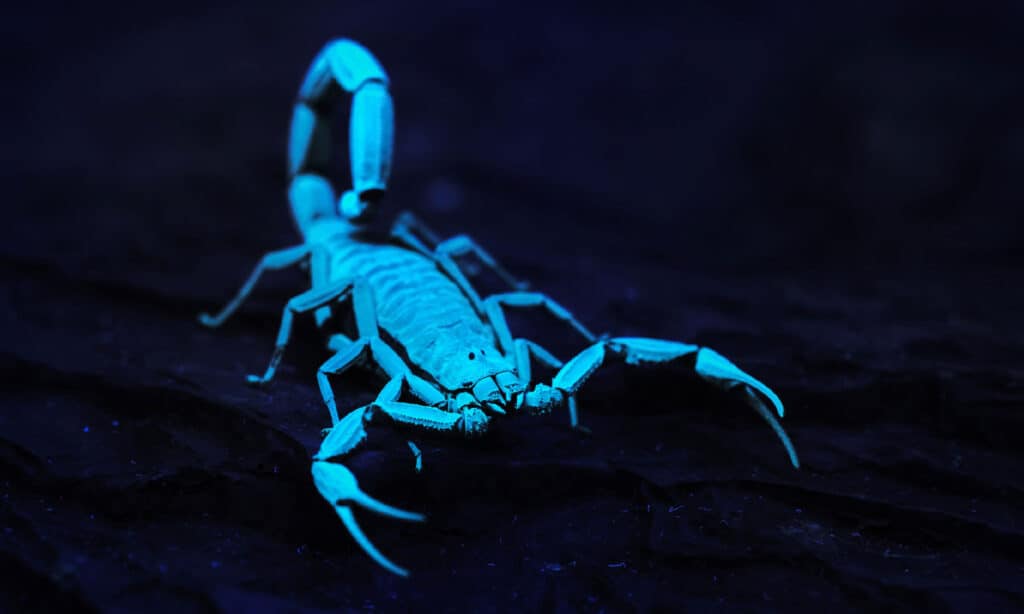
Using a black light is a great way to hunt scorpions in the dark.
©iStock.com/alekseystemmer
Scorpions glow under blacklights due to a chemical in their exoskeleton. Sometimes moonlight will make them glow as well. Scientists still don’t understand exactly how this works.
Scientists also don’t understand why scorpions need to glow under certain light. Since scorpions are nocturnal, it is not in their best interest to be spotted at night. Some have suggested it’s a sunblock, a way to confuse prey, and a way to identify if it is daylight.
Once a blacklight is shown on a scorpion, it’s an easy target for capture. Arizonans stalk scorpions at night in an attempt to keep their populations under control in residential areas.
Scorpions that are caught around a home should be relocated to the open desert. They play a vital role in local ecosystems.
Are Scorpions Older Than Dinosaurs?
Yes, scorpions are older than dinosaurs. Dinosaurs came into existence about 245 million years ago and went extinct 66 million years ago. Scorpions arrived on earth more than 400 million years ago.
The dinosaurs were wiped out in the Cretaceous extinction event, which is the 5th to have occurred on the planet. This event forced most of the species on the planet into extinction. However, some small species did survive, including scorpions.
Scorpions of some form have survived all of earth’s extinction events, making them one of the oldest and most durable animals on the planet. However, blooming interest in scorpion venom is endangering some scorpion species worldwide.
None of the 4 scorpions on our list from Arizona is endangered.
Are Scorpions Edible?
Yes, scorpions are edible. That’s why some people call them land lobsters.
They’re a common street food in Southeast Asian countries like Thailand. Care is taken to remove the stinger from the scorpion’s tail properly, then it is often skewered and barbequed.
What Keeps Scorpions Away?

Use of certain essential oils like peppermint can help deter scorpions from entering your home.
©Madeleine Steinbach/Shutterstock.com
The best way to avoid getting stung by a scorpion is to try and prevent them from entering your house in the first place. As scorpions can get into your house through holes and cracks, you can check for possible entryways with a flashlight. If the light gets through from the inside to the outside, you should fill that hole or crevice with an appropriate product.
Keeping your yard free of debris helps cut down on areas scorpions would gravitate to. Scorpions are also drawn to moisture, so you should keep areas around your home dry where leaks or puddles may occur. Caulking doors and windows is also a good strategy to keep them out.
Scorpions hate certain scents, especially cinnamon, so you can sprinkle it around the baseboards of your home to help deter them. Essential oils like lavender, peppermint, cedar, and cinnamon can also be used near potential entry points in your home to keep these pests away.
Summary of 4 Scorpions in Arizona You Will Encounter
| Scorpion | Characteristics | |
|---|---|---|
| 1 | Arizona Striped Tail | Most common in AZ; found on ground in desert and hiding under rocks; usually 2 inches long |
| 2 | Arizona Bark | Sandy colored with a long metasoma; like to hide in tree bark; sting is venomous; swelling and pain at sting site, with possible muscle spasms; |
| 3 | Yellow Ground | Mistaken for Arizona bark scorpions; yellow in color; venom is mild to humans |
| 4 | Arizona Giant Hairy | Largest in Arizona; grow up to 6 inches long; their metasomas and pedipalps are hairy; burrow up to 8 feet below ground |
The photo featured at the top of this post is © Ernie Cooper/Shutterstock.com
Thank you for reading! Have some feedback for us? Contact the AZ Animals editorial team.




